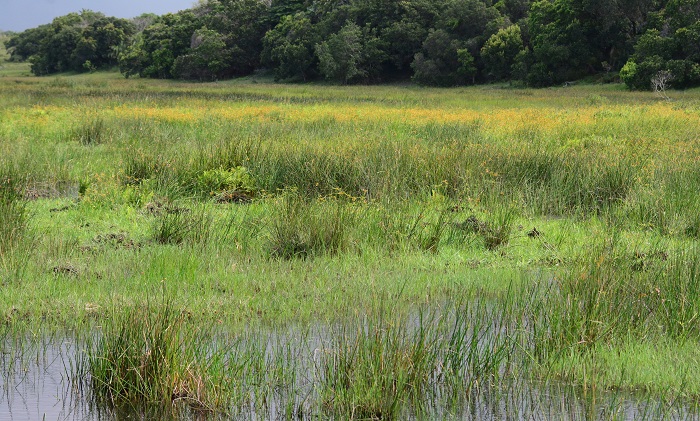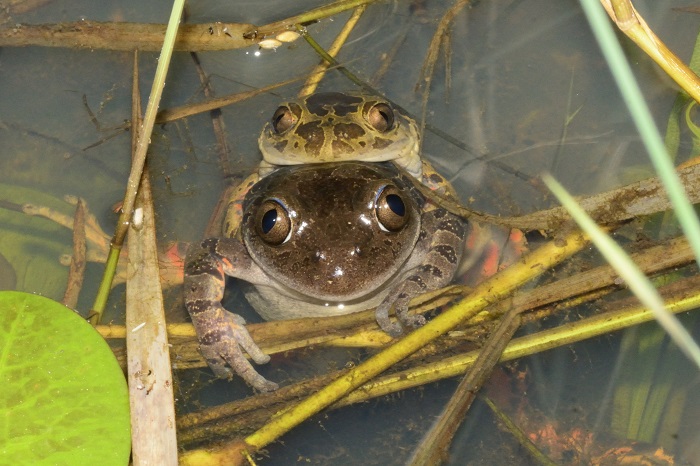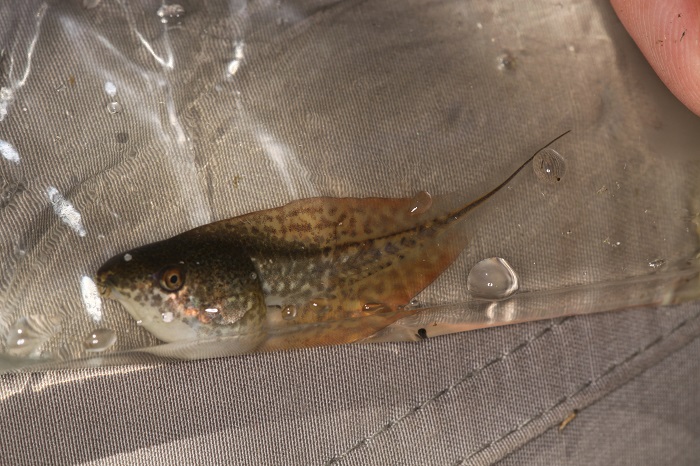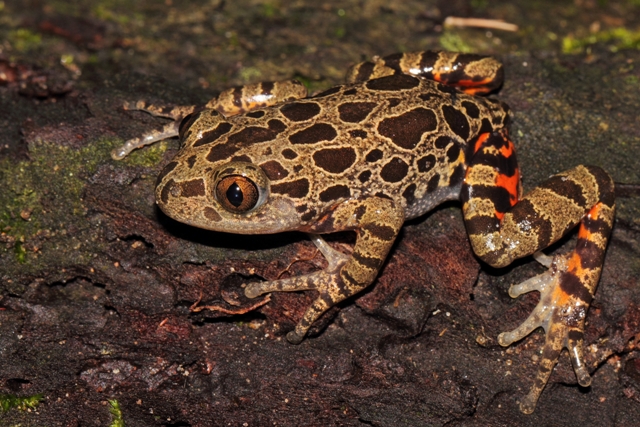View the above photo record (by Nick Evans) in FrogMAP here.
Find the Red-legged Kassina in the FBIS database (Freshwater Biodiversity Information System) here.
Family Hyperoliidae
RED-LEGGED KASSINA – Hylambates maculatus
Duméril, 1853
Habitat
This species inhabits a wide variety of bushveld vegetation types, predominantly Mixed and Sweet Lowveld Bushveld, and Coastal Bushveld-Grassland, in the Savanna Biome. The breeding habitat consists of well-vegetated pans, vleis, marshes and dams.

Photo by Ryan Tippett
Behaviour
Outside of the breeding season, during the dry winter months, H. maculatus has been found in cavities excavated in the damp mud at the bottom of empty pans (Pienaar et al. 1976), or under moist debris (Loveridge 1953a).

Photo by Andrew & Heather Hodgson
The breeding season usually begins in early November and continues until the end of February, depending on weather conditions (Bishop 1994). During the day, the frogs are rarely seen, remaining well hidden in clumps of dense vegetation (particularly Eleocharis limosa, Cyperus immensus and C. papyrus), and occasionally under logs or in the axils of banana leaves. Choruses develop in the late afternoon or early evening, before dusk. Males move closer to the water where they call from the water, well concealed under overhanging vegetation. Later they may be found calling from elevated positions, up to 50 cm above the water, in clumps of emergent vegetation (Bishop 1994). The males appear to have two distinct calling periods, one in the early evening (16:30–20:00) and another in the early morning, peaking between 02:00 and 03:00 (Bishop 1994). The advertisement call is a loud, short ‘quack’ repeated at intervals.
The eggs are laid singly or in lines of four or five, attached to submerged vegetation. The tadpoles are large and fish-like, similar to, but larger than those of K. senegalensis. They are up to 130 mm long with deep keel-like tails that arise from the top of the head.

Photo by Timo Paasikunas
H. maculatus is a voracious predator of invertebrates and also eats small frogs, such as Hyperolius marmoratus and Afrixalus aureus (Wager 1965; Channing 2001). K. maculata produces a characteristic odour when handled and is quite unpalatable, due to the production of defensive amines and peptides, such as caerulein and kassinin, by glands in the skin (Roseghini et al. 1988). In spite of these defences, there are records of predation on this species by the Yellowbilled Egret Egretta intermedia and the Vine Snake Thelotornis capensis (Channing 2001).
Status and Conservation
H. maculatus is locally abundant and occurs in a number of protected areas, including Kruger National Park. However, a major threat to this species is habitat loss through water drainage and afforestation. In several areas in KwaZulu-Natal, exotic Eucalyptus plantations have lowered the water table to such a degree that many pans in the coastal mosaic of forest, thicket and grassland, have completely disappeared. Nevertheless, the species does not appear to require special conservation action at present.

Photo by Alison Sharp
Distribution
H. maculatus is essentially a lowland species, although there is an unusual record of specimens from the Vumba Mountains (Zimbabwe) at an altitude of 1400 m (Poynton 1964). North of the atlas region, the species occurs throughout Mozambique and the eastern lowlands of Zimbabwe, Malawi, Tanzania and Kenya. In the atlas region, H. maculatus ranges from Pafuri (2231AD) in northeastern Limpopo Province, through eastern Mpumalanga and eastern Swaziland to the coastal lowlands of KwaZulu-Natal, and south to Shakaskraal (2931AC).
Although seldom seen, these frogs can be easily identified by their characteristic call that carries a considerable distance. The atlas data are reliable and reasonably complete. Gaps in distribution in Mpumalanga and Limpopo provinces do not reflect an absence of the species.

Further Resources
Virtual Museum (FrogMAP > Search VM > By Scientific or Common Name)
More common names: Rooibeenvleipadda (Afrikaans)
Recommended citation format for this species text:
Bishop PJ, Tippett RM. Red-legged Kassina Hylambates maculatus. BDI, Cape Town.
Available online at http://thebdi.org/2021/10/30/red-legged-kassina-hylambates-maculatus/
Recommended citation format:
This species text has been updated and expanded from the text in the
2004 frog atlas. The reference to the text and the book are as follows:
Bishop PJ 2004 Hylambates maculatus Red-legged Kassina. In Minter LR
et al 2004.
Minter LR, Burger M, Harrison JA, Braack HH, Bishop PJ, Kloepfer D (eds)
2004. Atlas and Red Data Book of the Frogs of South Africa, Lesotho and
Swaziland. Smithsonian Institution, Washington, and Avian Demography
Unit, Cape Town.

